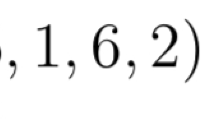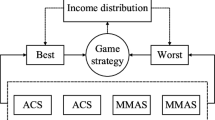Abstract
The emergence of novel metaheuristic algorithms and the impracticality of exact algorithms led to the increased application of stochastic optimization techniques to solve combinatorial optimization problems. Determination of population size, stopping criteria, selection of optimal parameter values, getting out of the local optima and most importantly the interplay between various parameters are yet to be addressed. In this work, the significance of population size and how it interplays with other parameters in determining the effective convergence of the system in both static and dynamic scenarios for travelling salesman problem (TSP) are explained. This work utilizes a more complex variant of introducing dynamism in TSP, by swapping existing nodes with new nodes. This work proposes novel local restart strategies for efficient search space reset during node replacements in dynamic TSP. The proposed local restart strategy in combination with hyper-populated ant systems is found to outperform existing state-of-the-art solutions on benchmark datasets including Oliver30, Eilon51 and KROA100 from TSPLIB.





Similar content being viewed by others
Explore related subjects
Discover the latest articles, news and stories from top researchers in related subjects.References
Bottou L (2010) Large-scale machine learning with stochastic gradient descent. In: Proceedings of COMPSTAT’2010 Physica-Verlag HD, pp 177–186
Bousquet O, Bottou L (2008) The tradeoffs of large scale learning. In: Advances in neural information processing systems, pp 161–168
Sieminski A (2015) Potentials of hyper populated ant colonies. In: Asian conference on intelligent information and database systems, pp 408–417
Salimans T, Ho J, Chen X, Sutskever I (2017) Evolution strategies as a scalable alternative to reinforcement learning. arXiv preprint arXiv:1703.03864
Gass SI, Harris CM (2012) Encyclopedia of operations research and management science. Springer, New York
Sorensen K (2015) Metaheuristicsthe metaphor exposed. Int Trans Oper Res 22(1):3–18
Kirkpatrick S, Gelatt CD, Vecchi MP (1983) Optimization by simulated annealing. Science 220(4598):671–680
Glover F (1989) Tabu searchpart I. ORSA J Comput 1(3):190–206
Beni G, Wang J (1993) Swarm intelligence in cellular robotic systems. In: Robots and biological systems: towards a new bionics? Springer, Berlin, pp 703–712
Kennedy J (2011) Particle swarm optimization. In: Encyclopedia of machine learning, pp 760–766
Dorigo M, Maniezzo V, Colorni A (1991) The ant system: an autocatalytic optimizing process. Technical report 1–21
Rosengren R (1971) Route fidelity, visual memory and recruitment behaviour in foraging wood ants of the genus Formica:(Hymenoptera, Formicidae). Societas pro fauna et flora Fennica
Deneubourg JL, Pasteels JM, Verhaeghe JC (1983) Probabilistic behaviour in ants: a strategy of errors? J Theor Biol 105(2):259–271
Gutjahr WJ (2000) A graph-based ant system and its convergence. Future Gen Comput Syst 16(8):873–888
Prakasam A, Savarimuthu N (2016) Metaheuristic algorithms and probabilistic behaviour: a comprehensive analysis of ant colony optimization and its variants. Artif Intell Rev 45(1):97–130
Yang Q, Chen WN, Yu Z, Gu T, Li Y, Zhang H, Zhang J (2017) Adaptive multimodal continuous ant colony optimization. IEEE Trans Evol Comput 21(2):191–205
Liu J, Yang J, Liu H, Tian X, Gao M (2017) An improved ant colony algorithm for robot path planning. Soft Comput 21(19):5829–5839
Chen Z, Wang RL (2017) Ant colony optimization with different crossover schemes for global optimization. Clust Comput 20(2):1247–1257
Wang J, Cao J, Sherratt RS, Park JH (2017) An improved ant colony optimization-based approach with mobile sink for wireless sensor networks. J Supercomput. https://doi.org/10.1007/s11227-017-2115-6
Sathiamoorthy J, Ramakrishnan B (2017) Energy and delay efficient dynamic cluster formation using hybrid AGA with FACO in EAACK MANETs. Wirel Netw 23(2):371–385
Zhang Q, Zhang C (2017) An improved ant colony optimization algorithm with strengthened pheromone updating mechanism for constraint satisfaction problem. Neural Comput Appl. https://doi.org/10.1007/s00521-017-2912-0
Rosset V, Paulo MA, Cespedes JG, Nascimento MC (2017) Enhancing the reliability on data delivery and energy efficiency by combining swarm intelligence and community detection in large-scale WSNs. Expert Syst Appl 78:89–102
Tsai CW, Tsai PW, Pan JS, Chao HC (2015) Metaheuristics for the deployment problem of WSN: a review. Microprocess Microsyst 39(8):1305–1317
Kaur S, Mahajan R (2018) Hybrid meta-heuristic optimization based energy efficient protocol for wireless sensor networks. Egypt Inform J. https://doi.org/10.1016/j.eij.2018.01.002
Zhang M, Yang M, Wu Q, Zheng R, Zhu J (2018) Smart perception and autonomic optimization: a novel bio-inspired hybrid routing protocol for MANETs. Future Gen Comput Syst 81:505–513
Zhang T, Ke L, Li J, Li J, Huang J, Li Z (2018) Metaheuristics for the tabu clustered traveling salesman problem. Comput Oper Res 89:1–12
Yan Y, Sohn HS, Reyes G (2017) A modified ant system to achieve better balance between intensification and diversification for the traveling salesman problem. Appl Soft Comput 60:256–267
Elhoseny M, Tharwat A, Yuan X, Hassanien AE (2018) Optimizing K-coverage of mobile WSNs. Expert Syst Appl 92:142–153. https://doi.org/10.1016/j.eswa.2017.09.008
Elsayed W, Elhoseny M, Sabbeh S, Riad A (2017) Self-maintenance model for wireless sensor networks. Comput Electr Eng. https://doi.org/10.1016/j.compeleceng.2017.12.022
Mavrovouniotis M, Muller FM, Yang S (2017) Ant colony optimization with local search for dynamic traveling salesman problems. IEEE Trans Cybern 47(7):1743–1756
Sieminski A (2015) Using ACS for dynamic traveling salesman problem. In: New research in multimedia and internet systems, pp 145–155
Sieminski A (2016) Using hyper populated ant colonies for solving the TSP. Vietnam J Comput Sci 3(2):103–117
Guntsch M, Middendorf M (2001) Pheromone modification strategies for ant algorithms applied to dynamic TSP. In: Workshops on applications of evolutionary computation, pp 213–222
Guntsch M, Middendorf M (2002) A population based approach for ACO. In: Cagnoni S, Gottlieb J, Hart E, Middendorf M, Raidl GR (eds) Applications of evolutionary computing. EvoWorkshops 2002. Lecture notes in computer science, vol 2279. Springer, Berlin
Mavrovouniotis M, Yang S (2010) Ant colony optimization with immigrants schemes in dynamic environments. Parallel Probl Solving Nat PPSN XI:371–380
Chen H, Jason T, Nor M (2007) Solving dynamic traveling salesman problem using ant colony system with local search. Int Multi Conf Eng Comput Sci. pp 117–121
Stutzle T, Hoos H (1998) Improvements on the ant-system: introducing the MAX-MIN ant system. In Artificial neural nets and genetic algorithms, pp 245–249
Zhang H, Zhou J (2016) Dynamic multiscale region search algorithm using vitality selection for traveling salesman problem. Expert Syst Appl 60:81–95
Chen SM, Chien CY (2011) Solving the traveling salesman problem based on the genetic simulated annealing ant colony system with particle swarm optimization techniques. Expert Syst Appl 38(12):14439–14450
Masutti TAS, Castro LND (2009) A self-organizing neural network using ideas from the immune system to solve the traveling salesman problem. Inf Sci 179(10):1454–1468
Cochrane EM, Beasley JE (2003) The co-adaptive neural network approach to the Euclidean traveling salesman problem. Neural Netw 16(10):1499–1525
Wilson EO (1971) The insect societies. Harvard University Press, Cambridge, MA (Distributed by Oxford University Press)
Nicolis G, Prigogine I (1977) Self-organization in nonequilibrium systems. Wiley, New York, p 191977
Moglich M, Holldobler B (1975) Communication and orientation during foraging and emigration in the ant Formica fusca. J Comp Physiolo A Neuroethol Sens Neural Behav Physiol 101(4):275–288
Verhaeghe JC (1982) Food recruitment in Tetramorium impurum. (Hymenoptera: Formicidae). Insectes Soc 29(1):67–85
Author information
Authors and Affiliations
Corresponding author
Ethics declarations
Conflict of interest
The authors have no conflict of interest to declare.
Rights and permissions
About this article
Cite this article
Prakasam, A., Savarimuthu, N. Novel local restart strategies with hyper-populated ant colonies for dynamic optimization problems. Neural Comput & Applic 31 (Suppl 1), 63–76 (2019). https://doi.org/10.1007/s00521-018-3638-3
Received:
Accepted:
Published:
Issue Date:
DOI: https://doi.org/10.1007/s00521-018-3638-3




